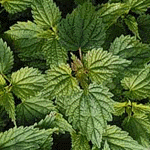|
|
The Eclectic Physician
Medicinal Herb Monographs
Stinging Nettle
Botanical Name
Urtica dioica
|

Urtica dioica
(Stinging Nettle)
|
The information on this page compiled by
Beth Burch N.D.
Index
(click on the keywords)
Introduction
Stinging nettle is a very valuable plant, used for food, medicine and fiber.
King’s American Dispensatory gives specific indications of chronic diarrhea
and mucous colitis, as well as chronic eczema. Recent uses include freeze-dried
nettle leaf for allergies, in particular, hay fever; and the root for prostate
enlargement. Because nettle is high in vitamins and minerals, it has long
been used as a nutritive green- as a tonic in the spring and also to prevent
scurvy. Fresh nettle juice is hemostatic and has been used for nosebleed
and excessive uterine bleeding. Weiss’ Herbal Medicine recommends nettle
or nettle juice for gout; research has shown nettle increases uric acid
excretion by the kidneys. Even the stings of the nettle plant can be used
externally as a counterirritant for arthritis and neuritis. King’s reports
the nettle sting may have use in cases of paralysis. The plant has also
been used as a dye and the fibers from the mature stalks make a strong
thread for weaving or for cor dage or rope.
[ Back to the Index. ]
Description
-
Stinging nettles are widespread throughout the world, preferring wet areas
including wastelands, woodlands and gardens. It is a perennial herb about
2-4 feet high with a 4 angled stem and opposite serrated leaves. The flowers
are small and green in trailing clusters. The plant has minute rigid hairs,
which when brushed result in a sting causing an initial itching and burning
with a welt, which over some minutes to hours transforms into a tingling,
somewhat numb sensation.
[ Back to the Index. ]
Constituents
-
In the fresh plant stinging hairs-
-
Histamine
-
Serotonin
-
Acetylcholine
-
Formic acid
-
Leaves-
-
Flavonoids including rutin
-
Silicic acid
-
Volatile oils including ketones
-
Potassium ions
-
Root-
-
Sterols- B-sitosterol, stigmasterol, campesterol
-
Lectins
-
Polysaccharides with immune stimulating effects
-
Hydroxycoumarins
-
Ceramides
-
Lignans
[ Back to the Index. ]
Action/Effects
-
Leaves-
-
Nutritive
-
Tonic
-
Anti-inflammatory(1)
-
Anti-allergy
-
Root-
-
Inhibits binding of sex hormone globulin to prostatic tissue receptors
(6,7)
-
Inhibits prostate cell metabolism and growth (4)
-
May inhibit viral activity
[ Back to the Index. ]
Conditions used
for
-
Leaves-
-
Hay fever (2)
-
Eczema
-
Hemorrhage-nosebleed, excessive uterine bleeding
-
Arthritis (1)
-
Chronic diarrhea
-
Root-
-
Benign prostatic hypertrophy- stages I & II (3,4,5)
[ Back to the Index. ]
Dosage
-
Leaves-
-
Extract- 1/2- 2 teaspoons three times a day
-
Freeze-dried- 300 mg three times a day
-
Juice- 1-3 teaspoons three times a day
-
Root-
-
Extract- 1/2- 2 teaspoons three times a day
-
Dry extract- 150-300 mg three times a day
-
Food Use
-
Harvest fresh nettles in the spring when they are less than 1 foot high
(use gloves unless you want to be stung), steam like spinach or other greens
or juice them.
[ Back to the Index. ]
Side Effects
[ Back to the Index. ]
Contraindications
-
Diabetes- may elevate blood sugar levels (8)
-
Allergy to nettles
-
Fluid retention from reduced cardiac or kidney function
[ Back to the Index. ]
Interactions
with medications
[ Back to the Index. ]
Use in
pregnancy & lactation
-
Dried nettle or nettle extract is widely used as a nourishing tonic for
pregnant women, however the fresh nettle has uterine stimulant action and
is contraindicated in pregnancy.
-
May help increase milk production in lactating women.
[ Back to the Index. ]
References
1. Obertreis B et al, Anti-inflammatory effect of Urtica dioica
folia extract in comparison to
caffeic malic acid, Arzneimittelforschung 1996;46(1):52-6
2. Mittman P, Randomized, double-blind study of freeze-dried Urtica
dioica in the
treatment of allergic rhinitis, Planta Med 1990;56(1):44-7
3. Lichius JJ et al, The inhibiting effects of Urtica dioica root extracts
on experimentally
induced prostatic hyperplasia in the mouse, Planta Med 1997;63(4):307-10
4. Hirano T et al, Effects of stinging nettle root extracts and their
steroidal components on
the Na+,K(+)-ATPase of the benign prostatic hyperplasia, Planta Med
1994;60(1):30-3
5. Krzeski T et al, Combined extracts of Urtica dioica and Pygeum africanum
in the treatment of
benign prostatic hyperplasia: double-blind comparison of two doses,
Clin Ther 1993;15(6):1011-20
6. Schottner M et al, Lignans from the roots of Urtica dioica and their
metabolites bind to human
sex hormone binding globulin (SHBG), Planta Med 1997;63(6):529-32
7. Hryb DJ et al, The effect of extracts of the roots of the stinging
nettle (Urtica dioica)
on the interaction of SHBG with its receptor on human prostatic membranes,
Planta Med 1995;61(1):31-2
8. Roman Ramos R et al, Hypoglycemic effect of plants used in Mexico
as antidiabetics, Arch Med Res 1992;23(1):59-64
[ Back to the Index. ]
* The information presented in this web site is intended to inform and educate.
It is not intended replace a qualified medical practitioner to diagnose or treat medical conditions.
|
|

